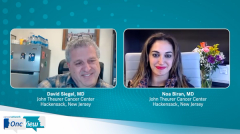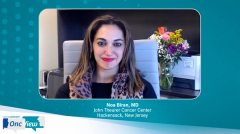
Closing Remarks on the MM Treatment Landscape
Nora Biran, MD, and David Siegel, MD, offer closing remarks on the MM treatment landscape.
Episodes in this series

Transcript:
David Siegel, MD: For me, the other critical thing going on in myeloma is what I started off talking about, that we have different flavors of myeloma. Myelomas evolve for completely different reasons. We can break myeloma up into 8 to 10 different categories now, and it will be more as our understanding of the biology improves. We’re going to start to have drugs that specifically target these different versions. The example I will use is that one of the really bad versions of myeloma can happen in patients with what we call t(4;14) translocations; the 2 chromosomes break and join, chromosome 4 and chromosome 14. And this leads to the evolution of one of the bad brands of myeloma. We have not been able to target that pathway.
Now, we have a couple of drugs that will target that pathway. We haven’t started to use them in any real sense right now. But we’re just opening a clinical trial for that exact set of patients. And that will continue to evolve.
There’s something about drugging the undruggable these days, where we can create situations in cancer cells that will particularly destroy the driver of individual types of cancer. It’s not something that’s usable today, but certainly in the near future. Noa is going to see these things evolving during the course of her career. I’ll see them starting during the course of my career. It’s a very interesting landscape both in terms of the science, and to be more and more hopeful about what’s going to happen to our patients.
Noa Biran, MD: That’s a great closing remark. With all the work that’s been done and with all these novel therapies, we still have a lot of work to do. I think it boils down to the biology of the disease, understanding the mutations, sequencing the genes of the cancer, understanding the driver mutations, and the genetic risk stratification. And how else can we risk stratify these patients and identify those patients who are going to relapse quickly, where we need to do more, and identify early the patients for whom maybe we can do less, or who are going to be pretty much cured with relatively little intervention?
Then the other aspect is the host, the immune system. How do we harness the T cells, the immune cells of the patient, to keep that disease under control and prevent depletion of the NK [natural killer] cells and effector cells? At the same time, we have a patient in front of us who has a family, a life. They have toxicity, they may be frail. We need to use these therapies wisely and maximize the quality of life of our patients all at the same time. It’s very overwhelming, but doable.
David Siegel, MD: We’ve gathered a remarkable set of physicians and an even more remarkable set of patients. But we’ve also partnered now, we finally have our own medical school and our own research institute, and we’ve gathered some remarkable scientists. We have the opportunity to be at the center of what is evolving in myeloma. Thank you for listening to the two of us.
Noa Biran, MD: Thank you very much. We hope this was valuable.
Transcript edited for clarity.
Newsletter
Stay up to date on recent advances in the multidisciplinary approach to cancer.



















































































